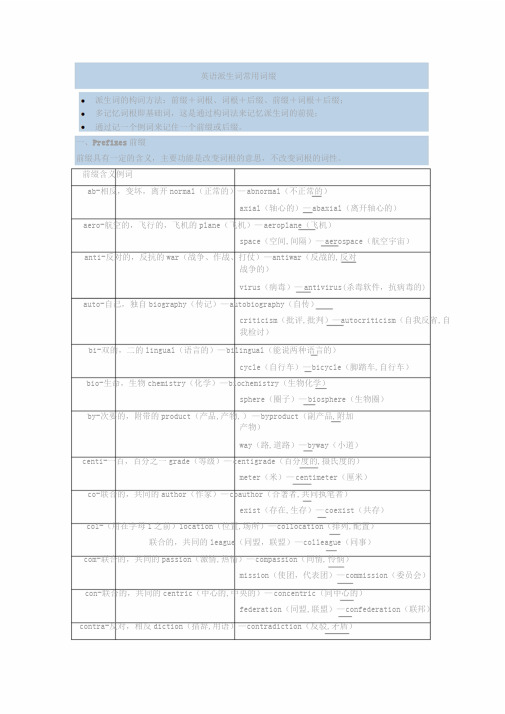构词法—派生法(前后缀)
- 格式:pdf
- 大小:12.46 KB
- 文档页数:4

artificial的构词法"Artificial" 这个词的构词法属于派生法(Derivation),具体来说是通过添加前缀来改变一个词的意义。
在"artificial" 这个词中,词根是"fact" 或"fac",它与"做" 或"制作" 有关。
而前缀"arti-" 来自于拉丁语"artus",意味着"由手" 或"用手工制作的"。
当"arti-" 这个前缀添加到词根"fact" 或"fac" 前,就形成了"artificial",表示"人工的" 或"非自然的"。
派生法是一种常用的构词法,通过添加前缀、后缀或改变词根的形式来创造新词或改变原有词的意义。
在英语中,前缀可以改变词的意义,后缀可以改变词的词性,而词根则提供了词的基本意义。
例如,通过添加不同的前缀,我们可以从"fact" 或"fac" 这个词根派生出一系列与制作或行为有关的词,如"factory"(工厂)、"facilitate"(使容易)等。
同样地,通过添加不同的后缀,我们可以改变"fact" 或"fac" 的词性,如"faction"(派系、小集团)就是一个名词形式。
总之,"artificial" 的构词法属于派生法,通过添加前缀"arti-" 来改变词根"fact" 或"fac" 的意义,表示"人工的" 或"非自然的"。


英语派生词常用词缀派生词的构词方法:前缀+词根、词根+后缀、前缀+词根+后缀;多记忆词根即基础词,这是通过构词法来记忆派生词的前提;通过记一个例词来记住一个前缀或后缀。
一、Prefixes前缀前缀具有一定的含义,主要功能是改变词根的意思,不改变词根的词性。
前缀含义例词ab-相反,变坏,离开normal(正常的)—abnormal(不正常的)axial(轴心的)—abaxial(离开轴心的)aero-航空的,飞行的,飞机的plane(飞机)—aeroplane(飞机)space(空间,间隔)—aerospace(航空宇宙)anti-反对的,反抗的war(战争、作战、打仗)—antiwar(反战的,反对战争的)virus(病毒)—antivirus(杀毒软件,抗病毒的)auto-自己,独自biography(传记)—autobiography(自传)criticism(批评,批判)—autocriticism(自我反省,自我检讨)bi-双的,二的lingual(语言的)—bilingual(能说两种语言的)cycle(自行车)—bicycle(脚踏车,自行车)bio-生命,生物chemistry(化学)—biochemistry(生物化学)sphere(圈子)—biosphere(生物圈)by-次要的,附带的product(产品,产物,)—byproduct(副产品,附加产物)way(路,道路)—byway(小道)centi-一百,百分之一grade(等级)—centigrade(百分度的,摄氏度的)meter(米)—centimeter(厘米)co-联合的,共同的author(作家)—coauthor(合著者,共同执笔者)exist(存在,生存)—coexist(共存)col-(用在字母l之前)location(位置,场所)—collocation(排列,配置)联合的,共同的league(同盟,联盟)—colleague(同事)com-联合的,共同的passion(激情,热情)—compassion(同情,怜悯)mission(使团,代表团)—commission(委员会)con-联合的,共同的centric(中心的,中央的)—concentric(同中心的)federation(同盟,联盟)—confederation(联邦)contra-反对,相反diction(措辞,用语)—contradiction(反驳,矛盾)natural(自然的)—contranatural(违背自然的)cor-(用在字母r之前)relate(使联系,发生关系)—correlate(使相互关联,和...相关)联合的,共同的respond(回答,反应)—correspond(符合,协调,相应)counter-相反,反对act(表现,见效)—counteract(抵消,中和,阻碍)attack(攻击)—counterattck(反引力)cross-横过,相反country(乡下的,乡村的)—crosscountry(越野的,横过田野的)cultural(文化的)—cross-cultural(跨文化的)de-剥夺,分离code(代码,密码)—decode(解码,译解)value(评价,重视)—devalue(减值,贬值)dis-分开,分离,否定,不advantage(优势,有利条件)—disadvantage(不利,不利条件,缺点,劣势)agree(同意)—disagree(不同意,不一致)em(用在b,m,p)body(赋以形体)—embody(具体表达,使具体化)power(权力,激励)—empower(授权与,使能够)en使成为danger(威胁)—endanger(危及)large(大的,巨大的)—enlarge(扩大,放大)ex前任的(还健在的)wife(妻子)—ex-wife(前妻)向外的port(港口)—export(出口)extra外面的curricular(课程的)—extracurricular(课外的,业余的)ordinary(平常的,普通的,平凡的)—extraordinary(非常的,特别的,非凡的)fore在前的,先的know(知道)—foreknow(先知)warn(警告)—forewarn(预先警告)hemi半的sphere(球体)—hemisphere(半球)cycle(球体)—hemicycle(半圆形)homo相同的type(类型)—homotype(同型)sexual(性的)—homosexual(同性恋的)il(用在l之前)legal(法律的,合法)—illegal(违法的)不,否literate(有文化的)—illiterate(文盲的,没受教育的)im(用在b,m,p之前)moral(道德(上)的,精神的,道德)—immoral(不道德的,邪恶的)不,否possible(可能的)—impossible(不可能的)in不,否direct(径直的,直接的)—indirect(间接的,迂回的)sensitive(敏感的,灵敏的)—insensitive(对...没有感觉的,感觉迟钝的)infra内部的,向内的structure(结构,构造)—infrastructure(下部构造,基础下部组织)red(红(色)的)—infrared(红外线的,红外线)inter相互的,之间的national(国家的,民族的)—international(国际的,世界的)face(面)—interface(界面,接口)intra内部的city(城市,都市)—intracity(市内的)department(部,局,处,科,部门,系,学部)—intradepartment(内部)ir(用在r之前)regular(规则的,有秩序的)—irregular(不规则的,无规律的)不,否responsible(有责任的,可靠的)—irresponsible(不负责任的,不可靠的)kilo千的gram(克,)—kilogram(千克,公斤)byte(字节)—kilobyte(千字节)macro大的,宏观的economics(经济学)—macroeconomics(宏观经济学)structure(结构)—macrostructure(宏观结构)micro微小的,微观的soft(软的)—microsoft(微软)electronics(电子学)—microelectronics(微电子学)mal坏的,错误的function(官能,功能,作用)—malfunction(故障)treat(宴请,款待)—maltreat(虐待,滥用)mid中的,中间的day(天,白天)—midday(正午)night(夜,夜晚)—midnight(午夜)mini小型的,迷你的bus(公共汽车)—minibus(小型公共汽车)skirt(裙子)—miniskirt(迷你短裙,超短裙)mis坏的,错误的,否定的fortune(运气,好运)—misfortune(不幸,灾祸)understand(懂,了解)—misunderstand(误解,误会)mono单一的plane(飞机)—monoplane(单翼机)tone(音调,语调)—monotone(单调的,单调)multi多的media(媒体)—multimedia(多媒体)national(国家的,民族的)—multinational(多民族的)non 非,无,不sense 理性,认识—n onsense (胡说,废话)stop 停,停站点—non-stop (直达的)out 向外live (活的,生动的)—outlive (比...长命,比...耐久)door (门,通道,家,户)—outdoor (室外的,户外的,野外的)over 在⋯⋯上面,优越,超越head (头,头的,主要的)—overhead (在头上的, 上,在空中,在高处)time (时间,时侯,时机)—overtime (超时,加班,超时的,加班的,使超时)poly 多的,多个的centric (中心的)—polycentric (多中心的)syllabic ([语]音节主音,音节的]—polysyllabic(多音节的)post 在⋯⋯之后graduate ((大学)毕业生,研究生)—postgraduate(研究所学生,研究生,毕业后的)war (战争,作战,打仗)—postwar (战后的)pre 在⋯⋯之前pay (薪水,工资,支付)—prepay (预付)w a r (战战,打仗)—prewar (战前的,在战前)pro 居前,领先a bortion —proabortion (流产,堕胎,失败,夭折,中 止,早产)pseudo 伪的,虚假,假拟n ame (姓名)—pseudonym (假名,笔名) science (科学,自然科学)—pseudoscience (假科学,伪科学)re 又,再unite (联合,团结)—reunite ((使)再结合)use (使用)—reuse (再使用,重新使用)self 自我employed (雇用,用,使用)—selfemployedtaught (teach 的过去式和过去分词)—selftaughtsemi 半,不完全的circle (圆周,圆形物)—semicircle (半圆形)final (决赛)—semifinal (半决赛)step 后,继mother (母亲,妈妈)—stepmother (继母)children (孩子,孩子们)—stepchildren (继子,继女)sub 下,在下;低于,次于,副,亚,divide (分,划分,分开)—subdivide (再分,细分) 次 section (部分)—subsection (分部,分段)super 超的,在⋯⋯之上market (市场)—supermarket (超级市场)natural (自然的,自然界的,普通的,正常的)—supernatural (超自然的,神奇的,超自然物,不可思议的事)tele 远距离传递,电视的screen (屏,银幕)—telescreen (电视屏幕,荧光屏)communication (交流)—telecommunication (远程通信)therm(o)热的,电热的chemistry (化学)—thermochemistry (热化学)meter (计,表)—thermometer (温度计,体温计)trans 横过,贯穿,在⋯⋯之间A tlantic (大西洋)—transatlantic (大西洋彼岸的)plant (种植,栽培,培养)—transplant (移植,移种)三,三倍angular (有角的)—triangular (三角形的)cycle (自行车)—tricycle (三轮车,机器三轮车)ultra 极端,过度modern (近代的,现代的)—ultramodern (超现代化的)sound (声音,语音)—ultrasound (超频率音响)un 不,非,无certain (确定的,必然的,可靠的)—uncertain (无常的,不确定的,不的,靠不住的)fortunate (幸运的,幸福的)—unfortunate (不幸的, 使人遗憾的) under 在⋯⋯之下,次于develop (发展,显影)—underdevelop ((使)发展不 完全,(使)显影不足) sea (海洋,大浪)—undersea (海面下的)uni 单一form (形态,构成)—uniform (统一的,相同的)directional (方向的)—unidirectional (单向的,单向性的)vice 副的,次的chairman (主席,会长)—vice-chairman (副主席,副议长)president (总统,会长,行长)—vice-president (副 ,副省长)二、Postfixes 后缀后缀的作用主要是改变单词词性,后缀有较强的可以决定词给词根以微弱。

英语单词的构词法英语单词的构成主要有派生、合成和转换三种。
派生分——前缀、后缀。
一、派生前缀——在词首添加固定字母组合,通常改变词义,不改变原词性。
如:动词否定前缀:dis——discover发现形容词、副词否定前缀:un,im,in——unhappy不高兴,impossible不可能动词的重复前缀:re——redo重做,recite背诵,record记录名词的遥远前缀:tele (多用于电信)——television,telescope望远镜,telegraph电报后缀——在词尾添加固定字母组合,通常改变词性,不改变原基本词义。
如:形容词后缀ful(基本词full)表示充满了什么——colorful天气后缀y——windy,sunny注意:少数后缀既改词义又改词性。
如:less为否定后缀(基本词为little的比较级)——homeless(无家)前缀构词法一览表后缀构词法一览表副词、数词、动词后缀1、词形变化最活跃的词——名词、形容词。
2、名词可以变形容词,形容词可以变副词,但名词不能直接变为副词,必须通过形容词过渡。
如:luck(名词)——lucky(形容词)——luckily(副词)care(名词)——careless(粗心的)——carelessly(粗心地)ly通常是副词的标志词尾,但少数名词+ly结尾的却是形容词。
如:friendly友好的,友谊的 lovely 可爱的,有趣的lively活泼的,活跃的 *lonely孤独的,独立的(alone孤独地,副词)二、合成合成构词法合成名词合成形容词合成副词合成代词合成动词有名词标记bedroom boo kshop football fri endship 友谊 day break 破晓 sunri se 日出 hand writingsun-bathing 日光浴water-skiing 滑水dining-roomswimming-pool 游泳池ba throom 浴室 pickpo cket 扒手 nobleman贵族midnight有形容词标记white-hairedkind-heartedcold-bloodedmiddle-agedgood-lookinghard-workingfull-time (全职的)part-time (兼职的)second-hand (旧的)manmadestate-ownedEnglish-speaking(说英语的)peace-lovingwell-knownwide-spreadanywherenowherehoweversomehow不知何故maybehimselfyourselfyourselveseveryoneeverybodyeverythingnothingnobodysomeonesomebody somethinganybodyanyoneanythinganotherOvercome 战胜uphold 支持whitewash 粉刷underline 划线illtreat 虐待overthrow 粉刷typewrite 打字其它形式get-together 联欢会breakfast 早餐其它形式take-away 可带走的ice-cool 冰凉的new-born 新生的world-famous三、转换转换构词法四、缩略词五、轻松单词的识记办法——“团记”。

四种常见的构词法构词法主要有四种:派生法、合成法、转换法和截短法。
一、派生法在一个词的词根的前面或后面加上某个词缀来产生新词,这种构词法称为派生法。
加在前面的词缀叫前缀,加在后面的词缀叫后缀。
(一)后缀:许多名词、形容词、副词和动词是由词根加后缀构成的。
1.构成名词的常用后缀有:(1)-er,-or,-ist,-ee,-ese,-ant等用于构成表示人或物的名称。
(2) -ance, -ence, -(a)tion, -sion, -ics, -ing, -ity, -ment, -ness, -th, -ty,-ure,-ship等用于构成表示行为、性质、状态等抽象名词。
2. 构成形容词的常用后缀有:-able, -ible, -al, -ful, -less, -ish, -ive, -ous, -an, -ary, -en等。
3. 构成副词的常用后缀有:-ly, -ward, -wise等。
4. 构成动词的常用后缀的有:-ise/ize, -en, -ify等。
(二)前缀:词根加前缀多数不改变词性,只引起词义的变化。
1. 表示相反意义的前缀有:un-, dis-, in-, im-, ir-, il-, de-等。
2. 表示其他意思的前缀有:re-(重新),mpost-(后的),fore-(先的)等。
二、合成法由两个或两个以上的词合成一个新词,这种构词法称为合成法(compoundin g)。
合成词之间有的要用连字符连接,有的直接连接在一起。
三、转换法在词行不变的情况下,一个单词由一种词性转换成另一种词性,称为转换(co nversion)。
转换后的词义与转换前的词义通常有密切的联系,但有时差异也很大。
有些双音节的词转换后,重音要发生变化。
通常名词重音在前,动词重音在后,有时读音也有不同。
四、截短法即将单词缩写,词义和词性保持不变,主要有截头、去尾、截头去尾等形式。
关于合成法:合成名词:构成方式例词名词+名词weekend周末;名词+动词daybreak黎明;名词+动名词handwriting书法;名词+及物动词+er/or pain-killer止痛药;名词+介词+名词editor-in-chief总编辑;代词+名词she-wolf母狼;动词+名词typewriter打字机。

轻松学会六大构词法英语单词的来源大致上分为五种:1)基本词(base)、2)合成词(combining words)、3)缩略词(shortening words)、4)拼缀词(blending words)、5)转类词(shifting words)。
其中的基本词是那些在今天看来已经不可再分的词。
一、【派生法】(derivation words)英语构词法中在词根前面加前缀或在词根后面加后缀,从而构成一个与原单词意义相近或截然相反的新词的方法叫作派生法。
1.前缀(prefix)除少数英语前缀外,前缀一般改变单词的意义,不改变词性;英语后缀一般改变词类,而不引起词义的变化。
(1)表示否定意义的前缀常用的有dis-, il-, im-, in-, ir-, mis-, non-, un-等,在单词的前面加这类前缀常构成与该词意义相反的新词。
例如:agree同意→disagree不同意fair公平的→unfair不公平的possible可能的→impossible不可能的understand理解→misunderstand误解(2)表示其他意义的前缀常用的有a-(多构成表语形容词), anti- (反对;抵抗), auto- (自动), co- (共同), en- (使), inter- (互相), re- (再;又), sub- (下面的;次;小), tele- (强调距离)等。
例如:co-worker 同事,帮手enlarge 使变大cooperate 合作rewrite 重写subway 地铁2.后缀(surfix)给单词加后缀也是英语构词的一种重要方法。
后缀通常会改变单词的词性,构成意义相近的其他词性;少数后缀还会改变词义,变为与原来词义相反的新词。
下面仅作简单介绍。
(1)构成名词的后缀常用的有-ence,-(e)r/ -or (从事某事的人),-ese (某地人),-ess (雌性),-ian (精通……的人),-ist (专业人员),-ment (性质;状态),-ness (性质;状态),-tion(动作;过程)等。
英语构词法构词法主要有三种:派生法、合成法和转换法。
派生法(在词根的前面或后面加上某个词缀)、合成法(由两个或两个以上的词合成一个新词)、转换法(在词形不变的情况下,一个单词由一种词性转换成另一种词性)。
一、派生法在一个词的词根(root)的前面或后面加上某个词缀来产生新词,这种构词法称为派生法(derivation)。
加在前面的词缀叫前缀(prefix),加在后面的词缀叫后缀(suffix)。
(一)后缀:许多名词、形容词、副词和动词是由词根加后缀构成的。
1.构成名词的常用后缀有:(1)-er,-or,-ist,-ee,-ese,-ant等用于构成表示人或物的名称。
例如:thinker(思想家),guesser(猜想者),translator(翻译者),conductor(导体);physicist(物理学家),dentist (牙科医生);employee(雇员), trainee (受训人员);physician(内科医生),Italian (意大利人);Japanese(日本人); assistant(助手)等。
(2) -ance, -ence, -(a)tion, -sion, -ics, -ing, -ity, -ment,-ness, -th, -ty,-ure,-ship等用于构成表示行为、性质、状态等抽象名词。
例如:acceptance(接受), assistance (帮助); dependence(依靠),confidence(信心);repetition (重复), preparation(准备); discussion(讨论),division (分开);physics (物理学),fabrics (纺织品); building (建筑物),wedding (婚礼);reality (现实), ability (能力); settlement(解决),argument (争论);greatness (伟大),hardness (硬度); warmth (温暖), length (长度);safety (安全), penalty (惩罚); failure (失败), pressure (压力);friendship(友谊), leadership(领导)等。
构词法(一)——派生法(Derivation)词根(root)+词缀(affixes)构成新词,前缀法和后缀法。
通常前缀改变意义,后缀改变词性。
一.Prefix 前缀(一)前缀一般不改变词性1. 表达否定意义:dis- 否定,相反,除去(n.前)Eg: dislike v. 讨厌;discover v. 发现im- in- ir- il- ; un- 不,非(adj.或adv.前)Eg: impolite adj. 不礼貌的;impossible adj. 不可能的inconvenient adj. 不方便的incorrect adj. 不正确的;irregular adj. 不规律的;irresponsible adj. 不负责任的;illegal adj. 违法的;illiterate 不识字的unhappy adj. 不开心的;unforgettable adj. 无法忘记的non- 无,非,不(n.或adj.前)Eg: nonconductor n. 绝缘体;nonsense n. 胡说,废话mis- 错,误,恶(v.前)Eg: mistake n.&v. 错误,误解;misunderstand v. 误解for- 弃,禁Eg: forget v. 忘记forbid v. 禁止2. fore- 先,前Eg:forecast v. 预报;foretell v. 语言3. pre- 预先,之前的Eg: predict v. 预测prepare v. 准备4. post- 在……之后Eg: postwar adj.战后的;postgraduate n. 研究生5. mid- 中Eg:mid-term n. 期中的; middle n. 中间6. re- 重新,再一次,复(v.前)Eg: repeat v. 重复;return v. 返回,还;recycle v. 循环7. tele- 远,电(简写中常省略)Eg: telephone n. 电话;telescope v. 望远镜8. ex- 离开,前Eg: exit n. 出口ex-president n. 前总统9. self- 自动,自我Eg: self-assessment n.自我评价self-confident adj. 自信的10. over- 过于,翻Eg: overuse n. 过度使用overturn v. 打翻11. under- 不够Eg: underestimate v. 低估;12. trans- 跨越,移Eg: transportation n. 交通运输;transplant v. 移植13. micro- 微型,微缩Eg: microscope n. 显微镜; microwave n. 微波,微波炉14. mini- 特小的Eg: miniskirt n. 迷你裙minibus 迷你公交车15. semi- 半Eg: semi-final n. 半决赛;semicircle n. 半圆16. mono- 单Eg: monologue n. 独白monopoly n. 垄断17. bi- 双Eg: bicycle n. 自行车bimonthly adj. 双月的18. tri- 三Eg: triangle n. 三角形triplet n. 三胞胎19. multi- 多Eg: multimedia n. 多媒体multinational adj. 多国的20. auto- 自动Eg: automatic adj. 自动的automobile n. 汽车21. sub- 下面的Eg: subway n. 地铁subtitle n. 字幕,副标题22. super- 超级,上层Eg: superman n. 超人;supermarket n. 超市23. inter- 之间的,相互Eg: international adj. 国际的Internet n. 超市(二)改变词性的前缀1. a- 向里,离开,加强(v.或n.前构成adj.或adv.,adj.前构成prep.或adv.)Eg: awake adj. 醒着的; along prep.沿着,顺着;aside prep.&adv. 在……旁边;在旁边2.en- 使成为(n.或adj.前构成v.)Eg: enjoy v. 享受encourage v. 鼓励enable v. 是能够二.Suffix 后缀:(改变词性)1. 名词后缀:1)-ship 状态,身份(n.或adj.后,构成抽象n.)Eg: friendship 友谊;hardship 艰难,困苦2)-ness 状态,性质(adj.后,构成抽象n.)Eg: business 生意;sadness 悲伤;happiness 幸福3)-man 人,男人(n.后)Eg:policeman 警察superman 超人4)-ion 动作,状态(v.后)Eg: action 动作invention 发明decision 决定5)-er, -or 人,动作者,职业(v.后)Eg: writer 作家;waiter 男服务员;actor男演员;doctor 医生6)-ist 职业;主义者(n.后)Eg: pianist 钢琴家;scientist 科学家;revolutionist 革命主义者7)-ese,-(ia)n 人,语言(国名后构成adj.或n.)Eg: Chinese 中国人,汉语;Japanese 日本人,日语;Russian 俄国人,俄语;Italian 意大利人,意大利语8)-th 结果,过程(adj.和v.后,构成抽象n.)Eg:truth 真相;length 长度9)-hood 身份,境遇,状态(n.后)Eg: childhood 童年;neighborhood 邻居10)-ty 性质,状态,程度(adj.后,构成抽象n.)Eg:honesty 诚实;safety 安全11)-age 状态,集合(v.或adj.后)Eg: shortage 短缺;marriage 婚姻12)-ment ……的结果,手段(v.后)Eg: movement 运动;development 发展13)–ure ……的动作或过程(v. 后)Eg: failure 失败;pleasure 愉快;pressure 压力14)–dom ……状态,地位(v.或adj.后)级别、地位(n.后)Eg: kingdom 王国freedom 自由15)–ity (adj.后)Eg: reality 现实;activity 活动;possibility 可能性16)–y 有……倾向的(v后)Eg: difficulty 困难;discovery 发现17)–al ……的过程或状态(v. 后)Eg: arrival 到达;refusal 拒绝;survival 幸存18)–ance ;–ence ……的动作或状态(v.后)Eg: dependence 独立;difference 不同;assistance 协助2. 形容词后缀:1)-ly 品质,……的,每……的(n. 后)Eg: friendly 友好的;weekly 每周的2)-able ;-ible 能够,可……的(v.或n.后)Eg: acceptable 可接受的;unforgettable 无法忘记的3)-ed ……的,动作(v.或n.后)Eg: excited 感到兴奋的;surprised 感到惊讶的4)-ing 属于,性质,动作,状态(n.后构成n.或adj.,加在v.后构成n.)Eg: exciting 令人兴奋的;surprising 令人惊奇的;shopping 购物4)-en 由……制的(n.后)Eg: wooden 木头的;woolen 羊毛的5)-ern 方向(表方向的n.后)Eg: western 西方的;northern 北方的6)-ful 充满,……的(v.或n.后)Eg: colorful 多彩的;wonderful 棒极了7)-less 无……的,没有,不(n.或v. 后)Eg: hopeless 无望的;careless 粗心的8)-ive ……的,有……的(v.后)Eg: active 活跃的;productive 多产的9)-y (充满)……的(n.后)Eg: sporty 运动的;tasty 美味的10)-ish (多为贬义词)像……似的(n.后)Eg:childish 孩子气的,幼稚的;foolish 愚蠢的11)-like 类似;像Eg: childlike 孩子般的,天真的;womanlike 像女人的12)-ous 具有……性质的(n.后)Eg: dangerous 危险的;famous 著名的;courageous 有勇气的13)-some 引起……的;有……倾向的(n.和v.后)Eg: troublesome 麻烦的;handsome 英俊的;tiresome 令人生厌的14)-ary 与……有关的;……的(n. 后)Eg: revolutionary 革命的;customary 通常的,习惯的15)-ate 富于或显示某种性质(n.后)Eg: fortunate 幸运的;passionate 激情的16)-ant;-ent 处于……状态的;进行……动作的Eg: dependent 依赖的;different 不同的;consistent 持续的17)-ic ……的,关于……的Eg: classic 经典的;historic 历史性的;energetic 精力旺盛的18)-al ……的(n.后)……的状态或过程(v.后)Eg: arrival 到达;refusal 拒绝;survival 幸存3. 动词词缀1)-ize; -ise 成为……;使像……;使……化;以……的方式对待或处理;置于(n.或adj.后)Eg: realize 实现;organize 组织;criticize 批评2)-en 使,变得(adj.后)Eg: widen 拓宽;deepen 加深;sadden 使忧伤3)-ify 使得;变得(n.或adj.后)Eg: identify 识别;classify vt.分类,归类4. 副词词缀-ly 品质,……地(adj. 后)Eg: beautifully 优美地;slowly 慢慢地5. 数词词缀:1)-teen 十几(13-19)Eg: fifteen 十五;nineteen 十九2)-ty 几十(整数)Eg: twenty 二十;thirty 三十3)-th 第几(除尾数为1,2,3的)Eg: fifth 第五;ninth 第九6. 代词词缀-self(-selves)反身代词Eg: myself 我自己;ourselves 我们自己。